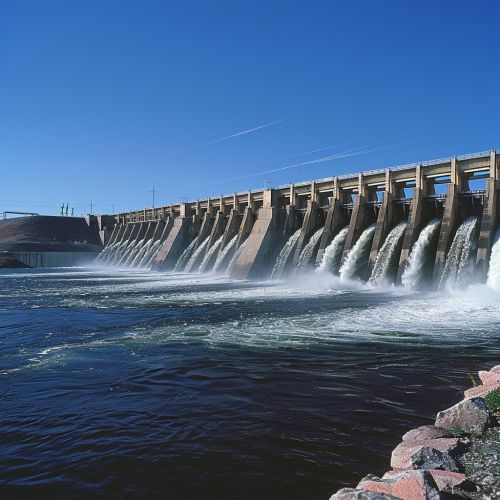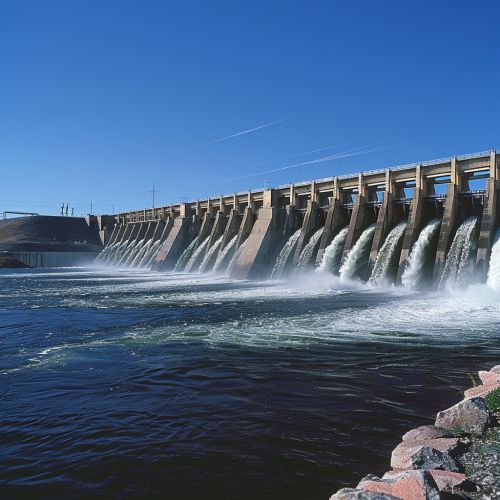Hydroelectric Power: Difference between revisions
(Created page with "== Introduction == Hydroelectric power, also known as hydroelectricity, is a form of renewable energy that harnesses the energy of flowing or falling water to generate electricity. This method of power generation is one of the oldest and most widely used forms of renewable energy, contributing significantly to the global energy mix. Hydroelectric power plants convert the kinetic energy of water into mechanical energy using turbines, which is then transformed into electri...") |
No edit summary |
||
| Line 26: | Line 26: | ||
The generated electricity is transmitted through power lines to homes, industries, and other consumers. Transformers are used to step up the voltage for efficient long-distance transmission and step it down for local distribution. | The generated electricity is transmitted through power lines to homes, industries, and other consumers. Transformers are used to step up the voltage for efficient long-distance transmission and step it down for local distribution. | ||
[[Image:Detail-97309.jpg|thumb|center|A large hydroelectric dam with water flowing through its spillways.|class=only_on_mobile]] | |||
[[Image:Detail-97310.jpg|thumb|center|A large hydroelectric dam with water flowing through its spillways.|class=only_on_desktop]] | |||
== Types of Hydroelectric Power Plants == | == Types of Hydroelectric Power Plants == | ||
Latest revision as of 14:04, 27 July 2024
Introduction
Hydroelectric power, also known as hydroelectricity, is a form of renewable energy that harnesses the energy of flowing or falling water to generate electricity. This method of power generation is one of the oldest and most widely used forms of renewable energy, contributing significantly to the global energy mix. Hydroelectric power plants convert the kinetic energy of water into mechanical energy using turbines, which is then transformed into electrical energy through generators.
History
The use of water for mechanical power dates back to ancient civilizations, where water wheels were employed for grinding grain and other tasks. The first hydroelectric power plant was established in 1882 in Appleton, Wisconsin, USA. This marked the beginning of the modern era of hydroelectric power generation. Over the years, technological advancements have significantly increased the efficiency and capacity of hydroelectric power plants.
Principles of Hydroelectric Power
Hydroelectric power generation is based on the principle of converting the kinetic energy of flowing water into mechanical energy using a turbine, which is then converted into electrical energy by a generator. The process involves several key components:
Water Source
The primary requirement for hydroelectric power generation is a reliable water source, typically a river or a reservoir. The water source must have sufficient flow and elevation drop to provide the necessary kinetic energy.
Dam
A dam is often constructed to create a reservoir, which stores water and controls its flow. The dam increases the water level, creating a higher head (height difference) that enhances the potential energy of the water.
Penstock
A penstock is a large pipe that channels water from the reservoir to the turbines. The penstock is designed to withstand high pressure and minimize energy losses due to friction.
Turbine
The turbine is the core component of a hydroelectric power plant. It converts the kinetic energy of flowing water into mechanical energy. There are several types of turbines used in hydroelectric power plants, including Francis, Pelton, and Kaplan turbines, each suited for different head and flow conditions.
Generator
The generator is coupled to the turbine and converts mechanical energy into electrical energy. It operates on the principle of electromagnetic induction, where the rotation of the turbine induces an electric current in the generator's coils.
Transmission
The generated electricity is transmitted through power lines to homes, industries, and other consumers. Transformers are used to step up the voltage for efficient long-distance transmission and step it down for local distribution.


Types of Hydroelectric Power Plants
Hydroelectric power plants can be classified based on their size, design, and mode of operation. The main types include:
Impoundment Plants
Impoundment plants are the most common type of hydroelectric power plants. They use a dam to store river water in a reservoir. Water is released from the reservoir through turbines to generate electricity. The flow of water can be controlled to match electricity demand.
Run-of-the-River Plants
Run-of-the-river plants do not require large reservoirs. Instead, they use the natural flow of the river to generate electricity. These plants have minimal environmental impact but are dependent on river flow, which can vary seasonally.
Pumped Storage Plants
Pumped storage plants are used for energy storage and grid stabilization. They have two reservoirs at different elevations. During periods of low electricity demand, excess electricity is used to pump water from the lower to the upper reservoir. During peak demand, water is released from the upper reservoir to generate electricity.
Environmental Impact
While hydroelectric power is a clean and renewable energy source, it has several environmental impacts:
Habitat Disruption
The construction of dams and reservoirs can disrupt local ecosystems and displace wildlife. Aquatic habitats are particularly affected, as dams can block the migration of fish and other aquatic species.
Water Quality
Reservoirs can alter water quality by changing temperature, oxygen levels, and sediment transport. These changes can affect aquatic life and downstream water users.
Greenhouse Gas Emissions
Although hydroelectric power plants do not emit greenhouse gases during operation, reservoirs can produce methane, a potent greenhouse gas, due to the decomposition of organic matter in flooded areas.
Economic and Social Considerations
Hydroelectric power projects have significant economic and social implications:
Cost
The initial cost of constructing a hydroelectric power plant is high, but the operational and maintenance costs are relatively low. The long lifespan of hydroelectric plants makes them economically viable over time.
Displacement
Large hydroelectric projects can displace communities living in the area to be flooded. This can lead to social and cultural disruptions and requires careful planning and compensation.
Energy Security
Hydroelectric power contributes to energy security by providing a stable and reliable source of electricity. It can also help reduce dependence on fossil fuels and mitigate the impact of energy price fluctuations.
Technological Advancements
Advancements in technology have improved the efficiency and environmental performance of hydroelectric power plants:
Fish-Friendly Turbines
New turbine designs, such as fish-friendly turbines, aim to reduce the impact on aquatic life by allowing fish to pass through the turbines safely.
Small-Scale Hydropower
Small-scale hydropower systems, also known as micro-hydro, are being developed for remote and off-grid applications. These systems have minimal environmental impact and can provide sustainable energy to rural communities.
Digitalization
The integration of digital technologies, such as sensors and data analytics, enhances the monitoring and control of hydroelectric power plants. This improves efficiency, reduces downtime, and optimizes maintenance.
Future Prospects
The future of hydroelectric power is influenced by several factors:
Climate Change
Climate change can affect water availability and flow patterns, impacting hydroelectric power generation. Adaptation strategies, such as flexible water management and improved forecasting, are essential to address these challenges.
Policy and Regulation
Government policies and regulations play a crucial role in the development of hydroelectric power. Incentives for renewable energy, environmental regulations, and support for research and development can drive the growth of the hydroelectric sector.
Integration with Other Renewables
Hydroelectric power can complement other renewable energy sources, such as solar and wind, by providing grid stability and energy storage. Hybrid systems that combine multiple renewable sources are being explored to enhance energy resilience.
Conclusion
Hydroelectric power is a vital component of the global energy landscape, offering a renewable and reliable source of electricity. While it has environmental and social challenges, ongoing technological advancements and sustainable practices can mitigate these impacts. As the world transitions to a low-carbon future, hydroelectric power will continue to play a key role in achieving energy security and sustainability.
